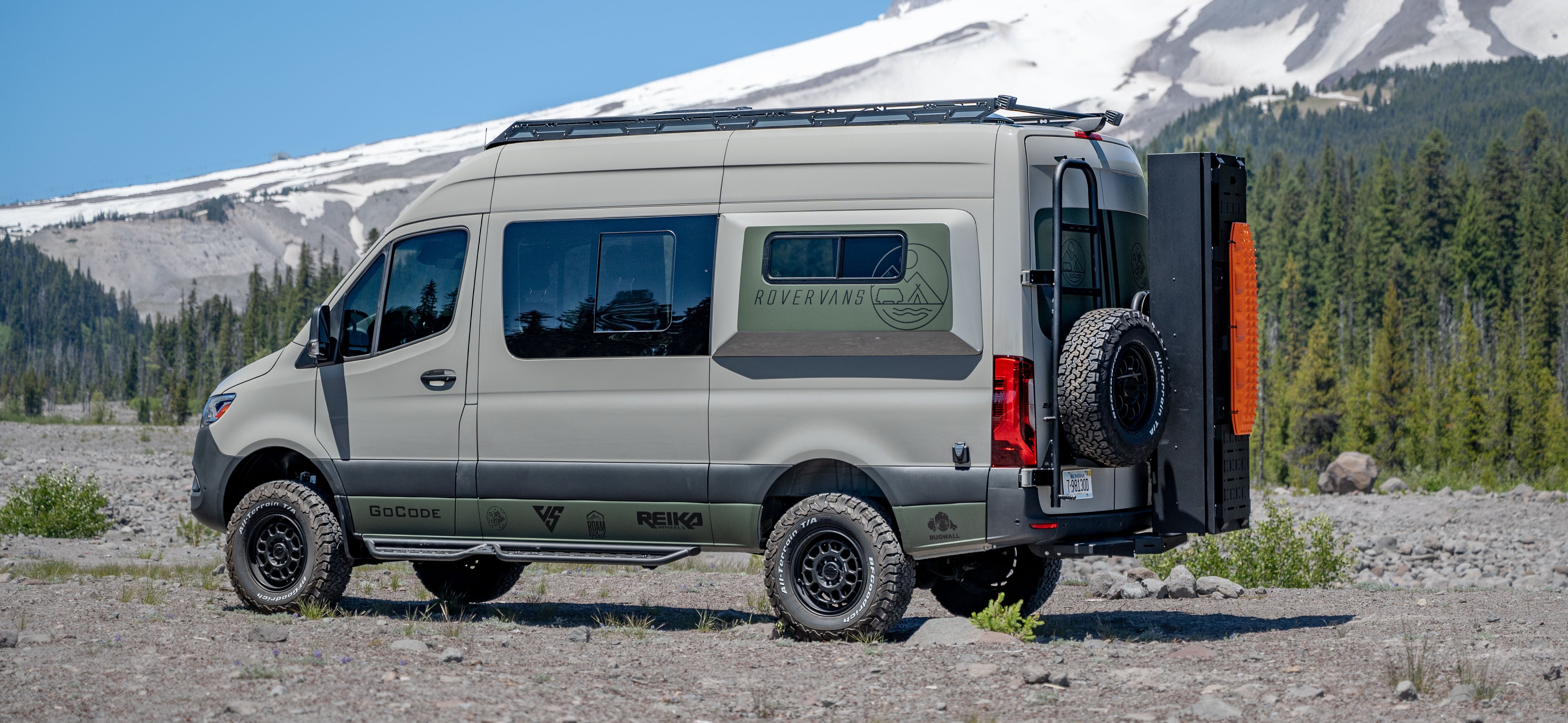Want to build your dream van but don’t know where to start? Don’t worry — this article is here to help. We’ve prepared guidelines and advice based on our knowledge and experience to guide you through the process. We hope you find it useful. Take the first step and build your van!
Why You Need a Solid Plan Before Starting Your Van Conversion?

Converting your van into a camper van without a clear plan will cost you time, money, and sanity. The best van builds start with intention.
Defining Your Budget and Lifestyle Needs
Start by asking yourself how you’ll use the van. Will it be your full-time home or a weekend adventure rig? Will you need a fixed platform bed or a convertible bed to share the space with bikes or gear? Your budget will also define whether you opt for custom cabinetry, a swivel seat upgrade, or pre-made kits. Knowing these factors shapes your van conversion layout before you spend anything.
Types of Van Conversion Plans – Which One Fits Your Lifestyle?
Van Conversion for Traveling Couples
Traveling couples often prioritise a permanent bed with storage underneath, a small kitchen, and a swivel seating area. A fixed platform bed allows you to store water tanks, electrical systems, and outdoor gear directly under the bed without compromising living space in the van.
Family-Friendly Van Layouts
Families need a different campervan layout. Bunk beds or convertible bench beds create sleeping space for kids. A full bathroom isn’t always essential, but having a toilet compartment and an outdoor shower can transform your van into a true camper van for extended trips.
Minimalist Van Life Setup
If you plan to build your van for minimalist vanlife, focus on open floor plans. A simple bench seat setup, pull-out platform bed, and portable cooking station will keep costs and weight down, giving you more storage space for mountain bikes, climbing gear, or work tools.
How to Create Your Own Van Conversion Plan – Step-by-Step Guide

Designing your van conversion layout isn’t just about where the bed goes. Every decision affects storage, workflow, safety, and comfort. Here’s a complete, realistic step-by-step guide.
You may also like: RV Essentials List: What Do You Need for Van Life?
Step 1: Define Your Core Needs
Before you open design software or buy parts, write down:
- How many people will live in your van? (solo, couple, family, friends sharing)
- Will you travel full-time or part-time?
- Do you need a fixed platform bed or convertible seating area?
- Do you want a full bathroom or just a portable toilet?
- What hobbies or work gear must fit in the van? (e.g. mountain bikes, surfboards, tools)
- Will you install swivel seats to expand living space?
This step prevents you from copying someone else’s van floor plan that won’t fit your life.
Step 2: Choose the Right Van

Your van choice determines your interior layout options. High-roof vans like the Mercedes Sprinter, Ram Promaster, or Ford Transit allow you to stand comfortably. A small van like the VW Vanagon or Nissan NV200 limits design but increases city mobility.
Step 3: Measure Everything
Measure your van’s interior floor length, width, and standing height – from metal to metal before insulation. Account for wheel arches, structural ribs, and the ceiling curve. Create a detailed sketch or import these dimensions into planning software.
Step 4: Decide on Bed Type and Placement
Choose between:
- Fixed platform bed: Ideal for couples and solo vanlifers who want large storage underneath.
- Convertible bed or murphy bed: Great for minimalists needing space in the van for daily activities.
- Bunk beds: For families or if you travel with friends.
Position your bed towards the rear or side, depending on how much room you want for your kitchen and seating area.
Step 5: Plan Your Kitchen Layout
Define your cooking needs:
- Full kitchenette with sink, fridge, and stove
- Portable camping stove setup
- Slide-out kitchen from the rear for outdoor cooking
Position your fresh water tank, grey water tank, and plumbing where they can drain easily. Ensure fridge vents have space for heat dissipation.
Step 6: Design Electrical and Heating Systems
Sketch your van conversion layout with these elements:
- Solar panel placement
- Battery bank and inverter location
- Wiring routes for lights, USB ports, fridge, fans, and water pump
- Diesel heater or propane heater location (vented safely)
- Switch panels for easy access
This step is crucial for safety, weight distribution, and maintenance.
Step 7: Maximise Storage Space
Add upper cabinets only where they don’t make the van feel cramped. Design under-bed drawers, kitchen base cabinets, and overhead storage strategically. Don’t forget hidden storage for valuables.
Step 8: Plan Ventilation and Windows
Decide where to install roof vent fans for airflow. Measure and plan window placements carefully – cutting a big hole in your van is permanent. Ventilation placement affects temperature control, cooking moisture, and sleeping comfort.
Step 9: Finalise Your Floor Plan
Combine all elements:
- Bed placement
- Kitchen layout
- Storage cabinets
- Seating area or swivel seats
- Electrical and plumbing routes
- Vent and window positions
Use tools like Vanspace 3D or SketchUp to visualise your layout. Adjust dimensions and test daily workflows inside the van virtually before building.
Step 10: Create a Build Schedule
Break your build into realistic phases:
- Demolition & cleaning
- Insulation & flooring
- Electrical & plumbing rough-in
- Framing & cabinetry
- Finishing touches & testing systems
A clear timeline keeps your van conversion process organised, ensuring each system integrates seamlessly.
Design Software and Planning Apps
Choosing the right design software can save you weeks of rework during your van conversion process. Here are the best tools and apps to design and build your van layout effectively:
1. Vanspace 3D

This popular software lets you create a detailed van conversion layout using pre-made models for cabinets, platform beds, swivel seats, and electrical components. You can walk through your design in 3D, check headroom, and adjust dimensions before building. Ideal for beginners who want quick visualisation.
2. SketchUp
A powerful, free (basic version) 3D design tool used by professional builders. SketchUp allows you to model every part of your camper van layout from scratch with precise measurements. Many vanlifers use it to design their cabinetry and electrical layouts.
3. Floorplanner
An intuitive web-based app to design floor plans quickly. Great for testing different van floor plans before investing time in detailed CAD drawings.
4. Van Conversion Calculator by FarOutRide
FarOutRide offers a detailed Van Electrical Calculator to plan your solar and battery needs based on real appliance usage, ensuring you buy the right components from the start.
5. RoomSketcher
While originally built for home design, RoomSketcher works well for quick van layout sketches to test cabinet and bed placements.
6. Shapr3D (iPad + Mac)
A powerful CAD app with Apple Pencil integration, perfect for van builders who want professional-level precision on the go.
Best Free and Paid Van Conversion Plans and Resources
Free Resources
YouTube Van Build Channels
- Kombi Life
- FarOutRide
- Kara and Nate Van Build
- The Indie Projects
These creators share full walkthroughs of their camper van layouts, electrical setups, and plumbing systems with materials lists.
FarOutRide Build Guides
FarOutRide provides detailed, free guides for their entire Promaster build, including wiring diagrams, insulation, and heating setup.
Reddit – r/VanLife and r/vandwellers
Great for feedback, community Q&A, and real-life camper van floor plan inspiration.
Paid Resources
Rover Vans Ready-Made Plans
Rover Vans offers ready-to-use van floor plans, including their Gladstone design, with modular cabinets, bench seats, and platform beds built to fit Promaster vans. Their parts are CNC-cut, easy to install, and ideal if you want a professional finish without a custom van build from scratch.
Van Build Guide eBooks
Many experienced vanlifers sell detailed PDF build guides with step-by-step processes, costs, and layout options for different vans. Examples:
- Gnomad Home Van Build Guide
- Vanlife Academy Conversion Guide
Ready-Made Van Conversion Plans to Simplify Your Build

If you want to skip planning headaches, ready-made floor plans from Rover Vans include everything from bunk layouts to kitchen cabinet dimensions. Their Gladstone plan is ideal for couples needing a fixed bed with storage underneath, while their van parts store offers modular cabinets, platform beds, and convertible seating areas that are easy to install.
Got questions or need help planning your build? Contact us at info@rovervans.com.
Inspiration Gallery – Real-Life Van Conversions That Work


See more in our gallery here >> Vans Build Gallery
Final Thoughts – What Every Good Van Conversion Plan Should Include?
Start with realistic budgeting to avoid surprises down the road. Then, set clear goals: are you chasing weekend escapes or planning a full-time off-grid adventure? Next, focus on the layout — think about how you’ll live, cook, sleep, and store your gear every day. Planning your floor plan, electrical system, and storage before you start cutting wood will save you time, money, and frustration. The best camper van layout is one that adapts to your daily rhythm and supports your van life dreams.





Aktie:
Is it Better to Buy a New or Used Camper?
5 Common Van Build Mistakes and How to Avoid Them